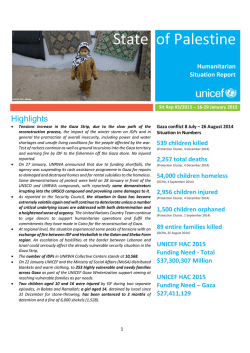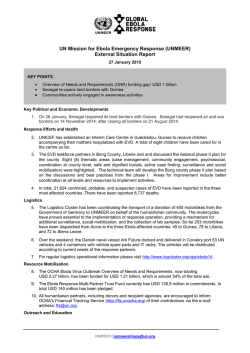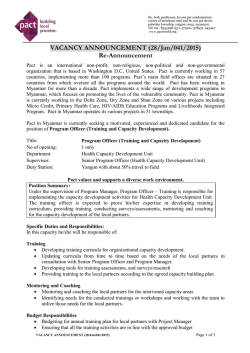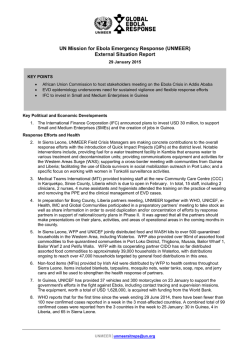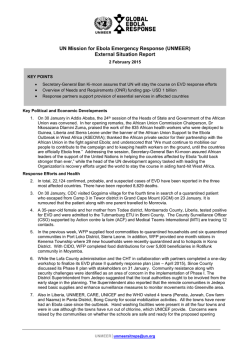
Download PDF
2015 © UNICEF /Myanmar/2013/Ko Kyaw Kyaw Win Humanitarian Action for Children Myanmar Total affected population: 536,000 Myanmar continues to face protracted emergencies in Kachin, northern Shan, and Rakhine States, placing over 536,0001 people, including 240,000 children, in need of humanitarian support. The civil conflict in Kachin and northern Shan has displaced more than 99,000 people since 2011, and inter-communal violence has displaced nearly 140,000 people in Rakhine since 2012. Additionally, 297,000 persons have been cut off from essential services by these crises, and their needs are compounded by Myanmar’s high exposure to natural hazards. In Rakhine, the conflict has deteriorated chronic underdevelopment, with global acute malnutrition rates (GAM) over 20 per cent in some areas, health services relying on mobile clinics, and low education access for all students, including only 8 per cent of adolescents in camps attending basic non-formal education. In Kachin and northern Shan, stunting is a major concern, as is access to adequate water supply, sanitation and hygiene (WASH) facilities. Children continue to face limited access to basic education and are at risk of protection issues, including recruitment and use by armed forces and armed groups, mine risks, gender-based violence and unsafe migration practices. Humanitarian strategy In 2015, UNICEF will continue to support the Government of Myanmar’s response to the humanitarian needs of over 536,000 children, men and women affected by conflict and natural hazards. UNICEF and partners are expanding assistance to children under age five with severe acute malnutrition, and are linking with national resilience-building platforms. UNICEF plans to support community-based solutions for increased access to water and improvement of its quality, WASH facility maintenance and hygiene promotion. UNICEF and partners will continue education support by providing temporary learning spaces (TLS) and capacity building on child-friendly education for volunteer teachers and school committees. UNICEF will continue to mitigate child protection risks through: psychosocial support in safe community spaces; mine-risk and lifeskills education; and the release of children associated with armed forces. As lead of the WASH cluster, nutrition sector, and child protection sub-sector, and co-lead of the education sector, UNICEF will continue coordinating with partners to provide life-saving and sustaining services with a results-based approach. UNICEF is investing in childcentred preparedness and disaster risk reduction strategies, while ensuring programmes are conflict-sensitive and 1 that they decrease vulnerabilities for children. Results from 2014 With 58 per cent (US$10,782,616) of the US$18.5 million 2014 appeal available as of the end of October, UNICEF and partners have focused on delivering conflict-sensitive emergency assistance, strengthening local self-reliance and resilience, and developing targeted services for IDPs and other affected persons. Due to access limitations, and limited but improving partner capacity, some targets have not been reached, and immunization campaigns have had to be moved to 2015. However, across both regions, over 241,000 children were screened for acute malnutrition, of whom 6,680 were treated for severe acute malnutrition (SAM). As lead of the WASH cluster, UNICEF and partners expanded WASH facilities and services for over 320,000 IDPs, and people in host and nearby communities affected by the crises. In education, 23,300 children gained access to learning opportunities, and 21,500 children in IDP camps and host communities were also provided with essential learning packages. The majority of child-friendly spaces support is provided by other actors, hence UNICEF is scaling down its support for this action and increasing support for case management services. As co-chair of the Country Task Force on Monitoring and Reporting, UNICEF The needs of some 400,000 people enduring prolonged displacement in the southeast are being addressed through a separate durable solutions framework and are not part the inter-sectoral response. Total affected children (under 18): 240,000 Total people to be reached in 2015: 280,000 Total children to be reached in 2015: 209,000 2015 Programme Targets Nutrition 4,005 children aged 6-59 months with SAM admitted to therapeutic care 28,098 children aged 6-59 months, and 7,618 pregnant and lactating women receive micronutrient supplementation (MNPs) 6,204 pregnant and lactating women access infant and young child feeding counselling Health 14,477 conflict-affected children aged 9-18 months receive measles immunization WASH 90,000 people have equitable access to sufficient and sustainable quantity of safe drinking and domestic water 98,000 people have equitable access to safe and sustainable sanitation facilities 98,000 have basic knowledge of diarrhoeal disease transmission and prevention Child Protection 100,000 children covered by child protection case management services Education 34,000 emergency-affected children in Kachin and Rakhine accessing primary and pre-primary learning opportunities www.unicef.org/appeals/myanmar facilitated the release of 376 children from the armed forces in 2014. 2014 PROGRAMME TARGETS AND RESULTS Cluster 2014 Targets Cluster Total Results UNICEF 2014 Targets UNICEF Total Results NUTRITION* Children aged 6 to 59 months with MAM receive supplementary feeding Rakhine 10,008 8,644 2,200 6,680 Children aged 6 to 59 months with SAM receive therapeutic feeding Rakhine 12,927 6,676 12,927 6,676 Kachin Rakhine Kachin Rakhine 9,169 50,220 3,652 13,113 7,791 24,329 2,406 16,874 5,700 50,220 2,200 13,113 7,791 24,329 2,406 16,874 Children aged 6 to 59 months receiving micronutrient supplementation Pregnant and lactating women receiving micronutrient supplementation HEALTH Households in affected areas receive two long-lasting insecticide-treated nets Kachin Rakhine 12,000 21,000 2,500 8,000 Women and children immunized with polio, measles, pentavalent and tetanus toxoid vaccines Rakhine 236,000 3,207 42,000 40,188 88,000 87,355 WATER, SANITATION and HYGIENE 107,424 173,729 Number of people (women, men, boys and girls) reached with emergency safe drinking water intervention Kachin 119,361 Rakhine 280,328 Number of people (women, men, boys and girls) reached with sanitation and hygiene education/promotion interventions Kachin 119,361 88,327 42,000 49,098 Rakhine 280,328 184,060 88,000 59,949 Kachin 119,361 90,000 42,000 48,833 Rakhine 280,328 230,539 88,000 87,355 Number of internally displaced and conflict-affected people provided with full emergency WASH package consisting of hygiene kits and associated hygienepromotion messages CHILD PROTECTION Children covered by child protection case management services Kachin 40,000 19,960 Rakhine 60,000 41,563 Children provided with psycho-social support through access to safe community spaces for socializing, playing and learning Kachin 20,000 4,240 Rakhine 30,000 16,741 EDUCATION* Primary- and pre-primary school children access quality education in safe temporary learning spaces with the provision of safe water, sanitation and hygiene Kachin 23,300 12,000 10,000 7,069 Rakhine 45,400 25,700 24,841 16,257 Results through 31 October 2014 unless otherwise noted *In Myanmar, Education and Nutrition are sectors, not clusters In line with Myanmar’s inter-agency 2015 Humanitarian Response Plan, UNICEF is requesting US$24,905,000 to meet the humanitarian needs of children in the country in 2015. Without additional funding UNICEF will be unable to support the national response to high levels of severe acute malnutrition and stunting, critical education services for children who have missed several years of schooling, necessary WASH support to avoid the spread of disease, and psychosocial support for children and adolescents. Without this support to provide life-saving services and build resilience, children in these areas are at further risk of deteriorating health and psychosocial protection issues. For further information please contact: Bertrand Bainvel Representative, UNICEF Myanmar Country Office Tel: +9512305960 Email [email protected] 2015 Requirements (US$) 3,055,000 5,722,000 Sector Funding requirements Nutrition Health Water, Sanitation & Hygiene 6,500,000 Child Protection 5,620,000 Education 3,500,000 Cluster/Sector Coordination Total Yasmin Haque Deputy Director, Office of Emergency Programmes (EMOPS), UNICEF, New York Tel: +1 212 326 7150 Email: [email protected] 508,000 24,905,000 Olav Kjørven Director, Public Partnerships Division (PPD) UNICEF, New York Tel: +1 212 326 7160 Email: [email protected]
© Copyright 2024
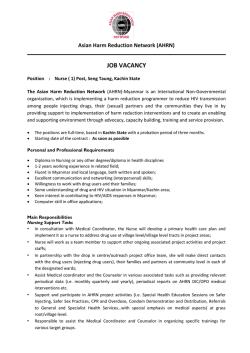
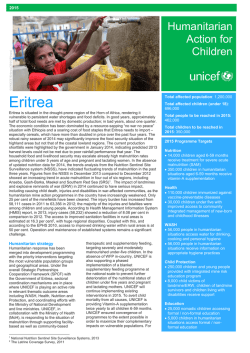
![Current appeal [PDF]](http://s2.esdocs.com/store/data/000476858_1-ff5bfc045afda14d4551c905d8c862b7-250x500.png)
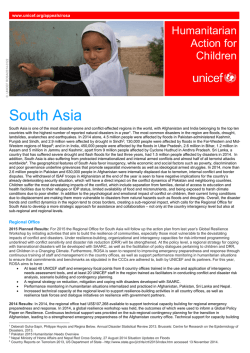
![Current appeal [PDF]](http://s2.esdocs.com/store/data/000470301_1-1a2ac0338c7b87d842a9839e11e746d1-250x500.png)
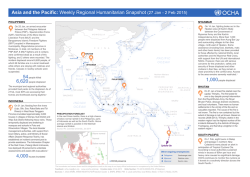
![Current appeal [PDF]](http://s2.esdocs.com/store/data/000456387_1-84443a4282546a8fcd8c29f2bdd10a65-250x500.png)
